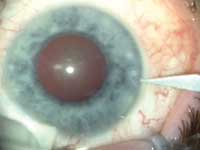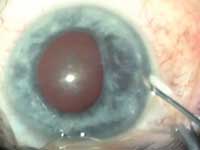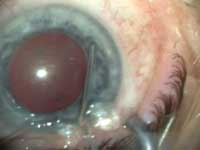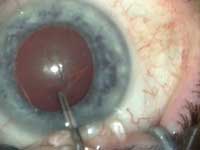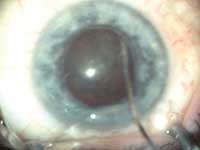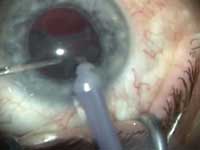Floppy iris syndrome manageable with the right viscoadaptive OVD
Although surgeons may find 2.3% sodium hyaluronate difficult to work with, it can stabilize the eye for safer phacoemulsification, surgeon says.
Click Here to Manage Email Alerts
Choosing the right viscoelastic can make the difference between a smooth and a complicated cataract surgery when faced with intraoperative floppy iris syndrome, according to one surgeon.
Using his expertise in the technical application of ophthalmic viscosurgical devices (OVD) in cataract surgery, Gerd U. Auffarth, MD, found that Healon5 (2.3% sodium hyaluronate, Advanced Medical Optics) can play an effective role in managing this complication.
According to Dr. Auffarth, 2.3% sodium hyaluronate can act as a pupil dilator in addition to stabilizing the anterior chamber for an easy capsulorrhexis and safe phacoemulsification.
“This keeps the iris away, and without touching the iris or without using any instruments for the iris, you can handle more or less all the cases with floppy iris syndrome,” he told Ocular Surgery News in a telephone interview.
Tamsulosin factor
Intraoperative floppy iris syndrome was brought to the attention of ophthalmologists in 2005 by David F. Chang, MD, and John Campbell, MD, as an unforeseen side effect of the prostatic hypertrophy drug Flomax (tamsulosin, Boehringer-Ingelheim Pharmaceuticals).
The relaxing effect of tamsulosin on the pupil may cause damage in what might at first appear to be a standard cataract surgery.
“If you have a case like this and you touch the iris or bite on the iris accidentally with your phaco handpiece, then the entire surgery will be a mess,” Dr. Auffarth said.
Usually, the iris has a perfectly normal appearance, and the only way cataract surgeons can avoid intraoperative surprises is by asking the patients specifically about tamsulosin, particularly if they are older than 70 years, he said.
“A more generic question such as ‘Are you taking any drugs?’ can be misleading because some of the patients assume that a medication they take for urinary or prostatic problems is of no interest for an eye doctor,” he said.
An OVD-only strategy
If a floppy iris occurs, the use of intraoperative tools such as iris retractors and pupil expanding devices can lead to more damage than benefit, which is why an OVD strategy is safer and more effective, according to Dr. Auffarth.
“When I started using Healon5, I found that this alone was more than enough to handle this type of patients,” he said. “At first, I used it to treat the floppy iris because it worked so much better than Healon (1% sodium hyaluronate) or Healon GV (1.4% sodium hyaluronate) in pushing and holding back the iris when it was protruding through the incision. Then I started using it from the beginning when I knew I was handling a potential floppy iris case.”
Preventively injected into the eye, 2.3% sodium hyaluronate acts as a pupil dilator, and it will stay in the anterior chamber, provided that a fairly low flow and vacuum rate are maintained, Dr. Auffarth said.
“It will not leak out, it will not be aspirated, and will keep the anterior chamber deep and the iris away from the phaco tip,” he said.
|
Images: Auffarth GU |
|
|
|
|
|
|
|
|
|
Balance in the phaco settings
As a viscoadaptive OVD that is cohesive or dispersive, depending on the flow rate used, 2.3% sodium hyaluronate can be difficult to remove from the eye at the end of surgery.
“This is probably the reason why this OVD is not used routinely by most surgeons and is regarded more as an emergency device for difficult, special cases,” Dr. Auffarth said.
It requires a fine balance in the choice of phacoemulsification settings, especially in situations such as floppy iris syndrome, he said.
High-volume cataract surgeons such as Dr. Auffarth usually set their vacuum and flow rates high to allow faster procedures. However, when dealing with a potential floppy iris and taking into account the dispersive quality of 2.3% sodium hyaluronate, these settings must be reduced. During surgery, flow rate should be kept less than 20 mL/min and vacuum less than 250 mm Hg, he said.
“If you have higher settings and you create turbulences, the viscoadaptive substance will break up in little pieces and will inevitably wash out,” Dr. Auffarth said.
At the end of surgery, the surgeon can increase the flow, as well as vacuum and irrigation rates, to remove the OVD.
A simple and effective method is to irrigate the majority of the viscoelastic first and then switch to a combination of irrigation and aspiration for the remainder, he said.
Additional techniques include manipulating the lens with the so-called rock ’n’ roll technique or two-compartment technique. Usually, a combination of these methods helps, he said.
Dr. Auffarth said he has been able to consistently use 2.3% sodium hyaluronate to manage cases of floppy iris syndrome without any instances of iris touch or bites.
“Floppy iris syndrome is a situation, and it becomes a complication if you cannot handle it. And with Healon5, you can handle the situation without getting into trouble,” he said.
For more information:
- Gerd U. Auffarth, MD, vice chairman of the Department of Ophthalmology at Heidelberg University and the head of the International Vision Correction Research Centre (IVCRC), can be reached at Universitäts Augenklinik Heidelberg, Im Neuenheimer Feld 400, D-69120 Heidelberg, Germany; +49-6221-566695; fax: +49-6221-561726; e-mail: ga@uni-hd.de or auffarthg@aol.com. Dr. Auffarth has no direct financial interest in the products discussed in this article, nor is he a paid consultant for any companies mentioned.
- Advanced Medical Optics, the maker of Healon5, can be reached at 1700 E. St. Andrew Place, Santa Ana, CA 92799, U.S.A.; +1-714-247-8200; fax: +1-866-872-5635; Web site: www.amo-inc.com.
- Michela Cimberle is an OSN Correspondent based in Treviso, Italy, who covers all aspects of ophthalmology. She focuses geographically on Europe. Additional reporting by Jared Schultz. Jared Schultz is an OSN Correspondent based in Philadelphia, U.S.A.

